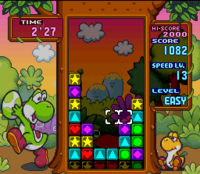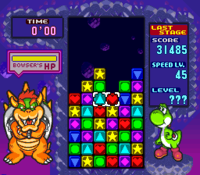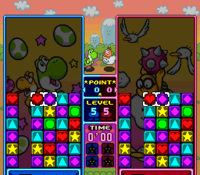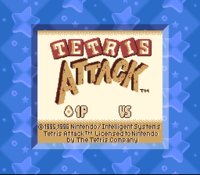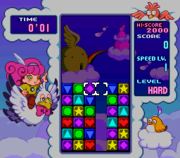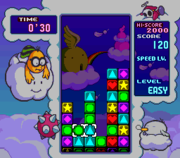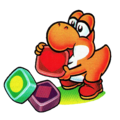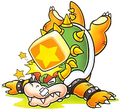Tetris Attack
Template:Infobox Tetris Attack is a Super Nintendo Entertainment System and Game Boy puzzle game, featuring the Yoshi franchise as a theme, by reimagining the Japanese game Panel de Pon as a base. Despite its name, Tetris Attack has no relation to the Tetris series and was later renamed Puzzle League when the sequels (such as Dr. Mario & Puzzle League) were released.
Gameplay
The title of the game is very misleading in that the gameplay has little to do with Tetris. Instead, square panels rise from the bottom (called the "stack") and the job of the player is to line up three or more matching panels either horizontally or vertically as the stack rises.
The player controls the panels using a rectangular cursor on the screen which the player uses to switch the selected panels back and forth. Extra points are given for combinations of more than three. If the stack touches the top of the playing field while rising, the game is over.
Single player mode
Endless
In Endless mode, players play to try to achieve the best possible score before they get a game over. Players can choose the difficulty level (Easy, Normal, Hard) and the speed level (lv. 1-99) to start out. However, the longer they manage to stay alive, the faster the stack will start to rise. If the player manages to reach a score of 99,999, the credits sequence will play.
Time Trial
The Time Trial mode is also similar to the Endless mode, except players are given a time limit of two minutes, and the objective is to score as many points as possible before time is up.
Stage Clear
This mode is just like the Endless mode (see above), except players must clear all the panels above the "clear line" that's drawn in the stack. The line is not visible at the beginning of the game, and is only visible when players have cleared enough panels for the stack to rise enough. If the stack touches the top before all the panels above the "clear line" are removed, the players will lose. There's no time limit in this game mode.
There's a total of 30 rounds (not counting the "special stage" and "last stage"), with five rounds per level.
The "special stage" and "last stage" involve defeating Bowser with combos and chains before the stack reaches the very top. While the "special stage" is only a bonus stage to test the players' skills, the "last stage" can be repeated if they lose.
Puzzle
In the puzzle mode, players are given a number of panels on the screen, and they must clear all of them with only a limited number of switches by the cursor. Players play ten rounds with up to six different characters. Also, at the end of each round, players are given a password, which they can use to come back to their game at a later time. There is no time limit for this game mode.
On a side note, there are some even more difficult puzzles that players can play with if they have the proper password.
VS
Single player VS is a game where players can battle the computer in a fight to free the players' allies from a spell cast by Kamek. One by one, the players and Yoshi must break the spell over each of their allies by battling and defeating them. The key to doing that is to dump Garbage Blocks, which resemble the Evil Ceiling from Wario's Woods, on their stack. There are special panels called Shock Panels. When three or more of these align, this creates a Shock Block, a special Garbage Block, which makes clearing Garbage Blocks more difficult. Each battle gets successively more difficult, and as the players progress and free their allies, they can use them in battle as well.
Inside Mt. Wickedness, the players will face off against Hookbill the Koopa and Naval Piranha on all the skill levels. On the "Normal" and "Hard" skill levels, Kamek will be the next opponent. And on the "Hard" skill level, the players will face Bowser as the final opponent.
There's also a "Super Hard" skill level, which will heavily test the players' skills. All opponents fought on the "Hard" skill level will be in this skill level.
Characters
While Mario, Luigi, Princess Peach, and Toad do not make a direct appearance in this game, Yoshi fights against Bowser and rescues his friends in the game's single-player versus mode, and he explains the gameplay to the player in the tutorials. A multitude of other characters from Super Mario World 2: Yoshi's Island appear in the game as well, some as allies and some as enemies. The following characters are:
Pals
The following characters can only be used in the VS game modes. There is an exception in the Game Boy version of the Puzzle game mode.
- Bumpty (SNES version only)
- Flying Wiggler
- Lunge Fish
Rivals
Note: All rival characters can only be used in the 2P Mode. There is an exception in the Game Boy version of the Puzzle game mode, however.
Secrets
Below are a list of secrets that can be found. None of them stay unlocked, however.
SNES
- Upon turning on the SNES, press the following buttons;
,
,
,
. If done correctly, the player will hear a chime. When the player does a one-player game mode, the stack will not stop, regardless of if the player does a combo or chain.
- In the 1P VS mode, the player can play the "Super Hard" skill level by pressing D-Pad Up,
, and
at the same time while the "Hard" skill level is selected. If done correctly, the lower background will turn dark red. The dark red background is a sign that the player is playing on the "Super Hard" skill level.
- Players can use the rival characters in the 2P game modes by doing the following; player 1 and player 2 must hold the
and
buttons at the same time while on the character select screen. If done right, the "? panels" will change into the rival characters.
Super Game Boy
When the Game Boy version is played on a Super Game Boy, certain button codes, if "1P" is selected at the title screen, trigger six secret borders, which are based on the background designs used for Yoshi's and his pals' stages in the SNES edition. The borders and their corresponding codes are as follows:
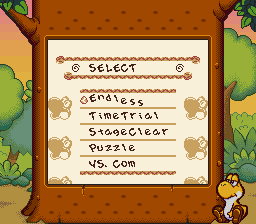 Yoshi stage border |
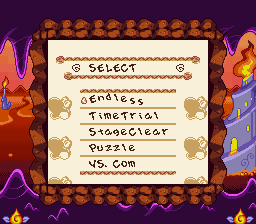 Gargantua Blargg stage border |
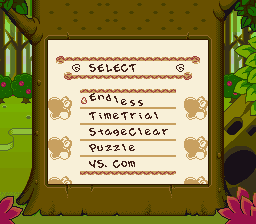 Poochy stage border | |
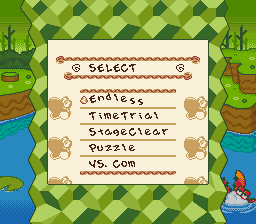 Froggy stage border |
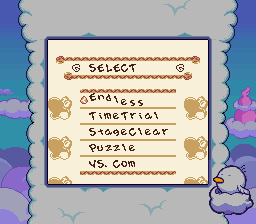 Lakitu stage border |
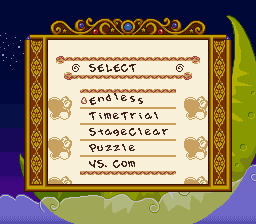 Raphael the Raven stage border |
The player can return to the title screen at any time to choose another border. Pressing just on the title screen will make the border the default star border again, while pressing the
button will keep the current border.
Options
The SNES version of the game does feature an "Options" menu, which enables the player to change the language settings, listen to sound effects and background music, and even view data about the characters.
There's also a "CPU Switch" feature, in which player 1 and/or player 2 will be controlled by a CPU player. However, this feature can't be used to view game endings in the single player game modes; if attempted, the player will get a message stating that the CPU Switch must be turned off to view the ending.
Panel de Pon
Originally, Tetris Attack was Panel de Pon, released for the Super Famicom on October 27, 1995, starring a young fairy known as Lip. However, the game didn't actually make it to the West as-is. For the Western release, Nintendo changed all the characters to Yoshi characters and enemies and renamed it.
Aside from the Yoshi motif, there were other gameplay changes, such as a password system for the story mode and Garbage Blocks were not customized for each character, unlike Panel de Pon.[1]
References in Mario games
In the Super Smash Bros. series, Lip's Stick, an item used by Lip, is an item throughout the series. Kirby's Stone move can turn him into many objects, including a Garbage Block from Panel de Pon. Panel de Pon music also appears in Super Smash Bros. Brawl, Super Smash Bros. for Wii U, and Super Smash Bros. Ultimate. The fairy Lip herself appears as an important character in Captain Rainbow. She also appears as a spirit and Mii Swordfighter costume in Super Smash Bros. Ultimate.
Re-releases
The Japanese version of Tetris Attack was released on the Satellaview without the Tetris name license. This version was a Japanese localization of the rebranded Panel de Pon with Yoshi characters. There was also an option in the menus to play the game with the characters and story dialogue in English, but the menus would stay in Japanese. The Game Boy version was also released in Japan as a standard cartridge.
Later, Nintendo attempted on releasing a remake of this game as part of the Nintendo Puzzle Collection along with Yoshi's Cookie and Dr. Mario. However, Nintendo Puzzle Collection also ended up being canceled in all countries outside Asia and it became a Japan-only game.
The game was rebranded again, from Tetris Attack, as Puzzle League, now the permanent name for the style of gameplay, and released on a two-game cartridge, called Dr. Mario & Puzzle League, released internationally.
The original game was released on the Wii Virtual Console on November 27, 2007[2], on the Wii U Virtual Console on May 29, 2013, and on the New Nintendo 3DS Virtual Console on August 9, 2016, once again solely in Japan.[3]
Panel de Pon is also one of the 21 games included in the Nintendo Classic Mini: Super Famicom exclusive to Japan.[4]
Names in other languages
| Language | Name | Meaning |
|---|---|---|
| Japanese | パネルでポン Panerudepon |
"Pop" is the equivalent of 「ポン」 pon. |
| Korean | 패널로 퐁 Paeneollo pong |
Panel Pong |
Reception
The game was placed 17th in the 100th issue of Nintendo Power's "100 best Nintendo games of all time" in 1997.[5] Its average score on Gamerankings was about 90%[6].
Staff
- Main article: List of Tetris Attack staff
Gallery
- For this subject's image gallery, see Gallery:Tetris Attack.
- Yoshi TA.gif
Group artwork
Media
- For a complete list of media for this subject, see List of Tetris Attack media.
Names in other languages
| Language | Name | Meaning |
|---|---|---|
| Japanese | ヨッシーのパネポン Yosshī no Panepon ヨッシーのパネポンBS版 Yosshī no Panepon BS-han |
Yoshi's PanePon (Game Boy) Yoshi's PanePon BS Edition (Satellaview) |
Trivia
- A minigame from Mario Party 6 and Mario Party DS, called Block Star, resembles the stack of blocks but plays differently.
- Lip's theme music can be heard during the game tutorials.
- In the years following Tetris Attack's release, Henk Rodgers of The Tetris Company has stated that he regrets granting Nintendo permission to use the term "Tetris" in the game's title.[7]
External links
- Official Website from Nintendo (Panel de Pon)
References
- ^ Panel de Pon and Tetris Attack Comparison at The Mushroom Kingdom
- ^ http://www.nintendo.co.jp/wii/vc/vc_pa/
- ^ http://www.nintendo.co.jp/wiiu/software/vc/ja3j/
- ^ Nintendo. (June 27, 2017). ファミコンに続いて、スーパーファミコンが小さくなって再登場!. Nintendo. Retrieved July 24, 2017.
- ^ http://www.gamekult.com/communaute/forum/voirmessage.html?foid=13000909, retrieved 6/4/2009
- ^ http://www.gamerankings.com/snes/588787-tetris-attack/index.html
- ^ "Interview with Alexey Pajitnov and Henk Rogers on Tetris"
| Tetris Attack | ||
|---|---|---|
| Pals | Yoshi • Lakitu • Bumpty* • Poochy • Flying Wiggler • Froggy • Gargantua Blargg • Lunge Fish • Raphael The Raven | |
| Rivals | Hookbill The Koopa • Naval Piranha • Kamek • Bowser | |
| Other characters | Mr. Time* • Little Yoshi • Fly Guy • Goonie • Dr. Freezegood • Grinder • Eggo-Dil • Clawdaddy • Flamer Guy • Flopsy Fish • Shy-Guy • Toady | |
| Gameplay | Panel • Garbage block • Shock Panel • Shock Block | |
| Miscellaneous | Gallery • Media • Quotes • Staff | |
| * Exclusive to the SNES version. | ||
| Game Boy games | |
|---|---|
| Super Mario franchise | Alleyway (1989) • Baseball (1989) • Super Mario Land (1989) • Golf (1989) • Dr. Mario (1990) • Super Mario Land 2: 6 Golden Coins (1992) • Donkey Kong (1994) • Mario's Picross (1995) • Picross 2 (1996) |
| Donkey Kong franchise | Donkey Kong (1994) • Donkey Kong Land (1995) • Donkey Kong Land 2 (1996) • Donkey Kong Land III (1997) |
| Yoshi franchise | Yoshi (1991) • Yoshi's Cookie (1992) • Tetris Attack (1996) |
| Wario franchise | Wario Land: Super Mario Land 3 (1994) • Wario Blast: Featuring Bomberman! (1994) • Wario Land II (1998) |
| Miscellaneous | Tetris (1989) • The Legend of Zelda: Link's Awakening (1993) • Game & Watch Gallery (1997) • Game & Watch Gallery 2 (1997) |
